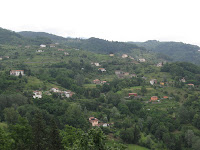 Another reason to go to Italy for me! This time it’s for a conference which was held at a resort 1 1/2 hours’ drive from Pisa, somewhere up in the middle of the mountains.
Another reason to go to Italy for me! This time it’s for a conference which was held at a resort 1 1/2 hours’ drive from Pisa, somewhere up in the middle of the mountains.又有機會去意大利了!這次出師有命,是要往離比薩一個半小時車程的一家「山莊」開會議。其實那是一家酒店,但位處有點偏僻的山頭上,所以稱之為山莊也頗為合適。
The conference was more than just a time to hear about the latest trends and developments in the field of electron microscopy. It was also a good opportunity to socialise, especially when the conference venue was so far away from anywhere else and kept all the attendants to the confines of the resort. With plentiful free periods and a relatively small crowd, it wasn’t too difficult to bump into other attendants and strike up conversations with them.
除了聽取行內最新動態和趨勢外,開會議另一大功能,莫過於和同行打打交道,在山莊舉行會議的一大目的,就是要把與會者「關」在一起,好讓大家多多溝通和接觸,由於人數少,空檔時間也多,所以是認識其他同行和交流的上佳機會。
The free periods also made for a few short trips near the resort. My colleagues and I went for a drive on the third day of the conference (17th June). Our first destination was the town of Barga, which was built atop a hill separated from the resort by a valley. It is an important part of the scenic backdrop to our resort!
空檔多也造就旅遊的時機,6月17日(會議第三日)我和同事便驅車往離山莊不遠的小鎮Barga遊覽。這個小鎮位於一座山上,與開會我們的山莊隔了個山谷,令山莊的景緻生色不少。


Barga was filled with sloped passageways, and at the summit of the town stood a church (Duomo di San Cristoforo) which provided a good vantage point for the surrounding hills and valleys.
Barga鎮內盡是山路,教堂(聖基度化教堂)位於全鎮最高處,四周山谷的景色盡收眼底。

Entrance to the town
Barga鎮的入口



Some of the streets within the town
鎮內的街道

Duomo di San Cristoforo (St. Christopher's Church, left) and its interior (bottom two)
聖基度化教堂(左)及其內部裝潢(下兩圖)



A local history museum by the church
教堂側的本地歷史博物館




The scenery from the church 教堂四周的景色

The hotel resort from Barga
從Barga回望山莊


Chiesa del Santissimmo Crocifisso (Church of the holiest crucifix)
聖十字架教堂
We continued our drive farther into the mountains. After so many twists and turns, and following our driving map and the many road signs, we reached a tiny non-descript town of Renaio, which probably contained not more than 20 houses altogether. We reckoned the only reason why Renaio was marked so prominently was that it was simply a convenient reference point for drivers on that road.
之後在附近的山頭兜兜,沿途盡是迂迴的山路,花了好一會,按地圖和路牌兜兜轉轉來到一個名為Renaio的小鎮,那是個名符其實的「小」鎮,民居也祇有十數家,也沒啥特色,大概祇是為了方便駕車人仕認路才在地圖和路牌上有所顯示吧。



A chestnut tree with a long history
歷史悠久的栗子樹
The hotel treated all attendants quite well throughout the conference, and at some stage some of us thought that we’ve been very well fed! (How could one resist Italian cuisine?) A bit of exercise was definitely much needed! So on the last day, I deliberately woke up earlier and went for a walk to a hill-top village called Treppingnana following the instructions provided by the resort. The whole expedition took a little more than an hour. There wasn’t too much to write home about, apart from the view of the valleys in the shroud of rather heavy fog or cloud. It felt a bit like looking down to the ground through the clouds from an aeroplane.
五天開會,住得好也吃得好(意大利菜又怎會令人失望?)差點忘了要做點運動,所以最後一天便提早起床,按酒店的遊客資訊,走到山莊附近的小鎮Treppingnana,路程要花一小時多一點,沿途的風景沒甚麼特別,倒在小鎮附近,總算看到霧(雲)鎖山谷的景色,有點從雲上看雲下的飄飄然之感,這躺晨運也算不枉了。

Treppingnana as seen from the resort
從山莊眺望Treppingnana

A farmhouse en route to Treppingnana
前往Treppingnana途中經過的一家村屋


The blue skies belong to the high up only!
雲層上,永遠是……另一個村莊


Inside Treppingnana Treppingnana村內景色
That afternoon I went on a tour to a vineyard. The owner took us everywhere and showed us how the wines were produced from grape pressing, fermentation to bottling. We were lucky enough to see the things ‘behind the scene’ since it’s not yet grape harvesting and fermenting. Afterwards she treated us to the range of home-grown wines, from a sparkling white wine (almost like a bubbly), normal white wine, red wine, dessert wine (Vin Santo, to accompany a special biscuit after a meal) and grappa. The alcohol had its desired effect: it's left some of us slightly emypt-headed, but certainly none of us empty-handed upon departure!
當日下午報名參觀釀酒園,抵達後酒園的女東主帶我們四處參觀其設備,由壓葡萄、發酵至入瓶整個流程,所有儀器及過程都解釋得一清二楚(當然現在不是葡萄收成及釀製期才能參觀廠房了)然後招待我們品嘗其出產的各種香檳、白酒、紅酒、甜酒(飯後甜品時配特別餅乾的Vin Santo酒)及烈酒(Grappa),務求令一眾團友不醉和不滿載無歸!



Pressing/extraction (top left), fermentation (top right) and bottling (left)
壓葡萄及榨汁(左)、發酵(右上)至入瓶(左)


A place to get merry, in the tavern 酒莊
I’ve enjoyed this conference a lot for what was offered by the conference itself and outside. My short break afterwards was even more memorable. More on that in my next post!
這次會議,會內、會外都有所收獲,之後三天的旅途更是難忘,下回再說!
Comments